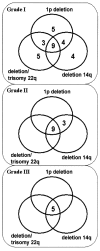Diagnostic and prognostic significance of genetic regional heterogeneity in meningiomas
- PMID: 15494096
- PMCID: PMC1872008
- DOI: 10.1215/S1152851704000158
Diagnostic and prognostic significance of genetic regional heterogeneity in meningiomas
Abstract
We analyzed the frequency and regional distribution of cells with genetic abnormalities of chromosomes 1, 14, and 22 in meningiomas. This data was evaluated for correlation to the clinical outcome of the patients. Eight defined areas of each of 77 paraffin-embedded meningioma samples (59 grade I, 13 grade II, and 5 grade III) were analyzed by fluorescent in situ hybridization using bacterial artificial chromosome probes localized to chromosomes 1p36.32, 1q25.3, 14q13.3, 14q32.12, 22q11.2, and 22q12.1-3. Chromosome deletion was considered to be regionally heterogeneous if 7 regions showed cells with chromosome deletions. Deletion of 1p occurred in 35% of the grade I tumors. Distribution of cells with 1p deletion was regionally heterogeneous in 25% and homogeneous in 10% of grade I tumors. Distribution of cells with deletion of 1p was regionally heterogeneous in 23% and homogeneous in 69% of the grade II tumors. All grade III meningiomas had homogeneous distribution of cells with deletion of chromosome 1p. Distribution of cells with deletion of 14q was regionally heterogeneous in 27% and homogeneous in 2% of the grade I meningiomas, heterogeneous in 31% and homogeneous in 62% of the grade II tumors, and heterogeneous in 40% and homogeneous in 60% of the grade III meningiomas. Distribution of cells with deletion of 22q was regionally heterogeneous in 15% and homogeneous in 3% of the grade I tumors, heterogeneous in 15% and homogeneous in 31% of grade II tumors, and homogeneous in 20% of the grade III meningiomas. Distribution of cells with trisomy 22q was regionally heterogeneous in 10% of grade I tumors, heterogeneous in 23% of grade II, and homogeneous in 80% of grade III meningiomas. The proportion of patients with a deletion of 22q (either homogeneous or heterogeneous) who had recurrence was greater than the proportion of those without 22q deletion who had recurrence, and deletion of 22q was significantly associated with radiologically detected recurrence (P < 0.05). We conclude that the appearance of chromosomal aberrations in different areas of the tumor demonstrates the importance of regional heterogeneity in the biological behavior of meningiomas.
Figures



References
-
- Adegbite AB, Khan MI, Paine KW, Tan LK. The recurrence of intracranial meningiomas after surgical treatment. J Neurosurg. 1983;58:51–56. - PubMed
-
- Bello MJ, de Campos JM, Kusak ME, Vaquero J, Sarasa JL, Pestana A, Rey JA. Allelic loss at 1p is associated with tumor progression of meningiomas. Genes Chromosomes Cancer. 1994;9:296–298. - PubMed
-
- Bello MJ, de Campos JM, Vaquero J, Kusak ME, Sarasa JL, Rey JA. High-resolution analysis of chromosome arm 1p alterations in meningioma. Cancer Genetics Cytogenet. 2000;120:30–36. - PubMed
-
- Bigner DD. Biology of gliomas: Potential clinical implications of glioma cellular heterogeneity. Neurosurgery. 1981;9:320–326. - PubMed
-
- Burger PC, Kleihues P. Cytologic composition of the untreated glioblastoma with implications for evaluation of needle biopsies. Cancer. 1989;63:2014–2023. - PubMed
Publication types
MeSH terms
Grants and funding
LinkOut - more resources
Full Text Sources

